Bài giảng Marketing
Why studies Marketing?
To be vital to business survival, profits & growth
Offer you good career opportunities
Affect your existing job and life everyday
Half of every dollar spent by consumers pays for
marketing costs
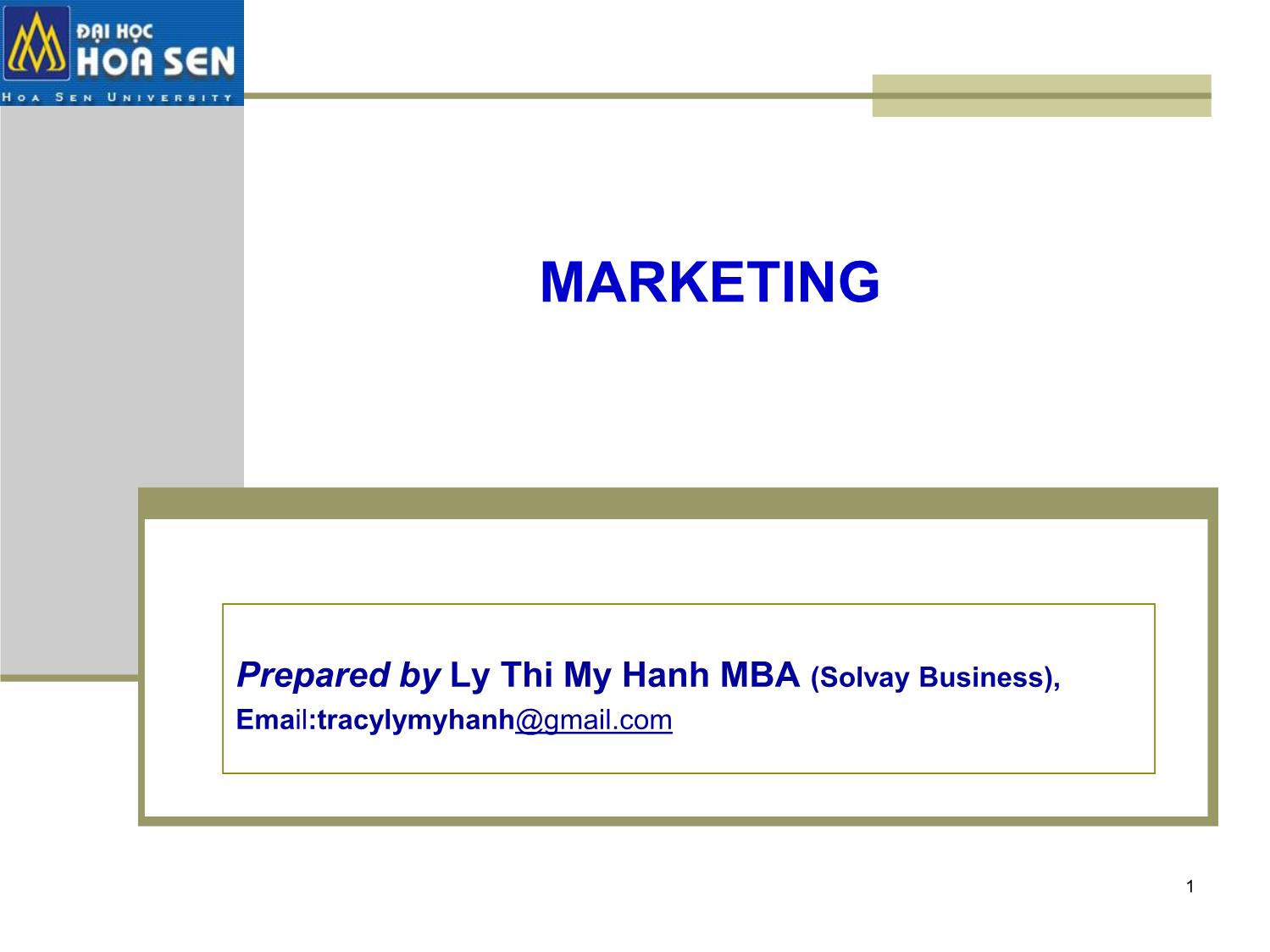
Trang 1
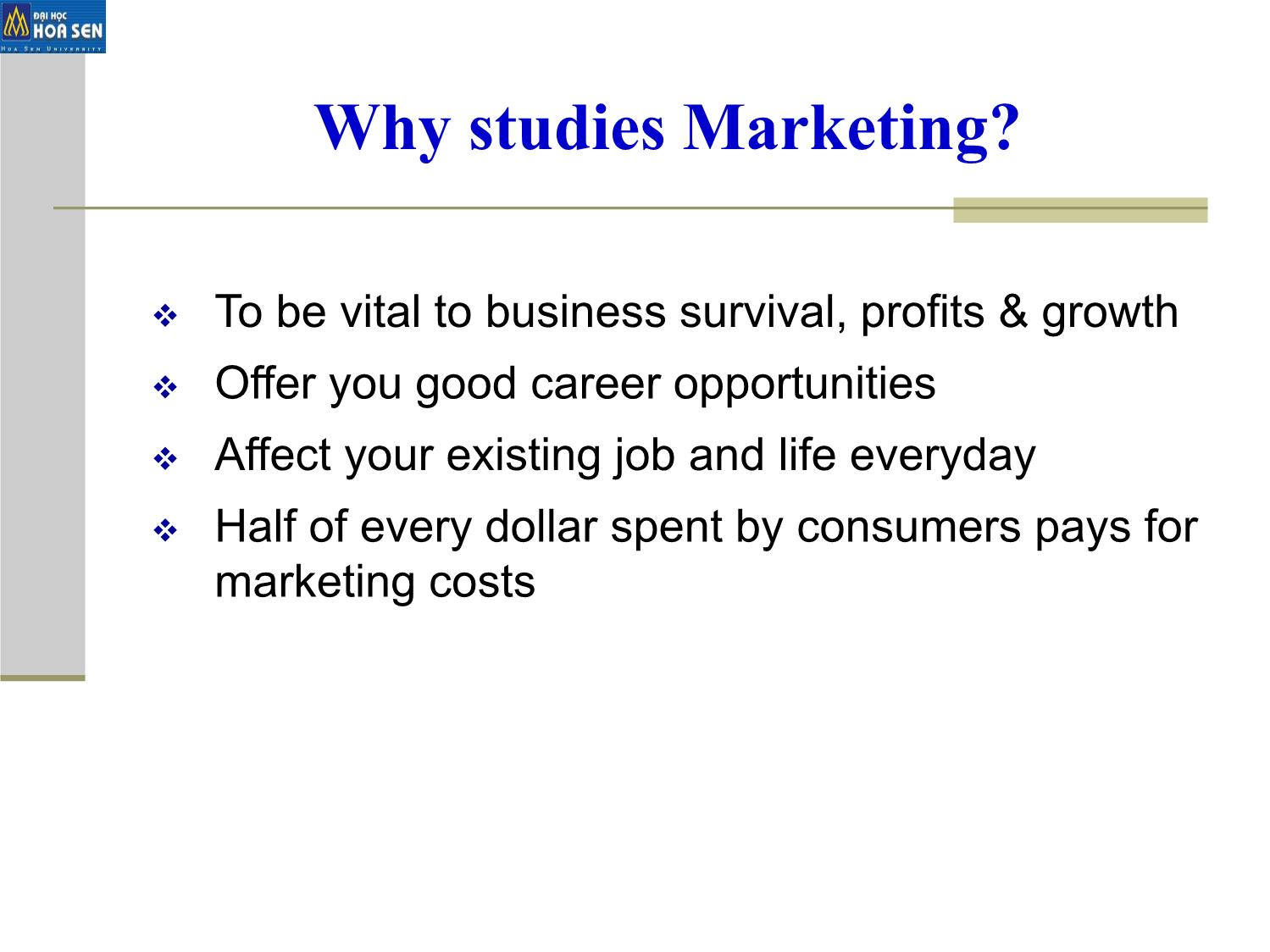
Trang 2
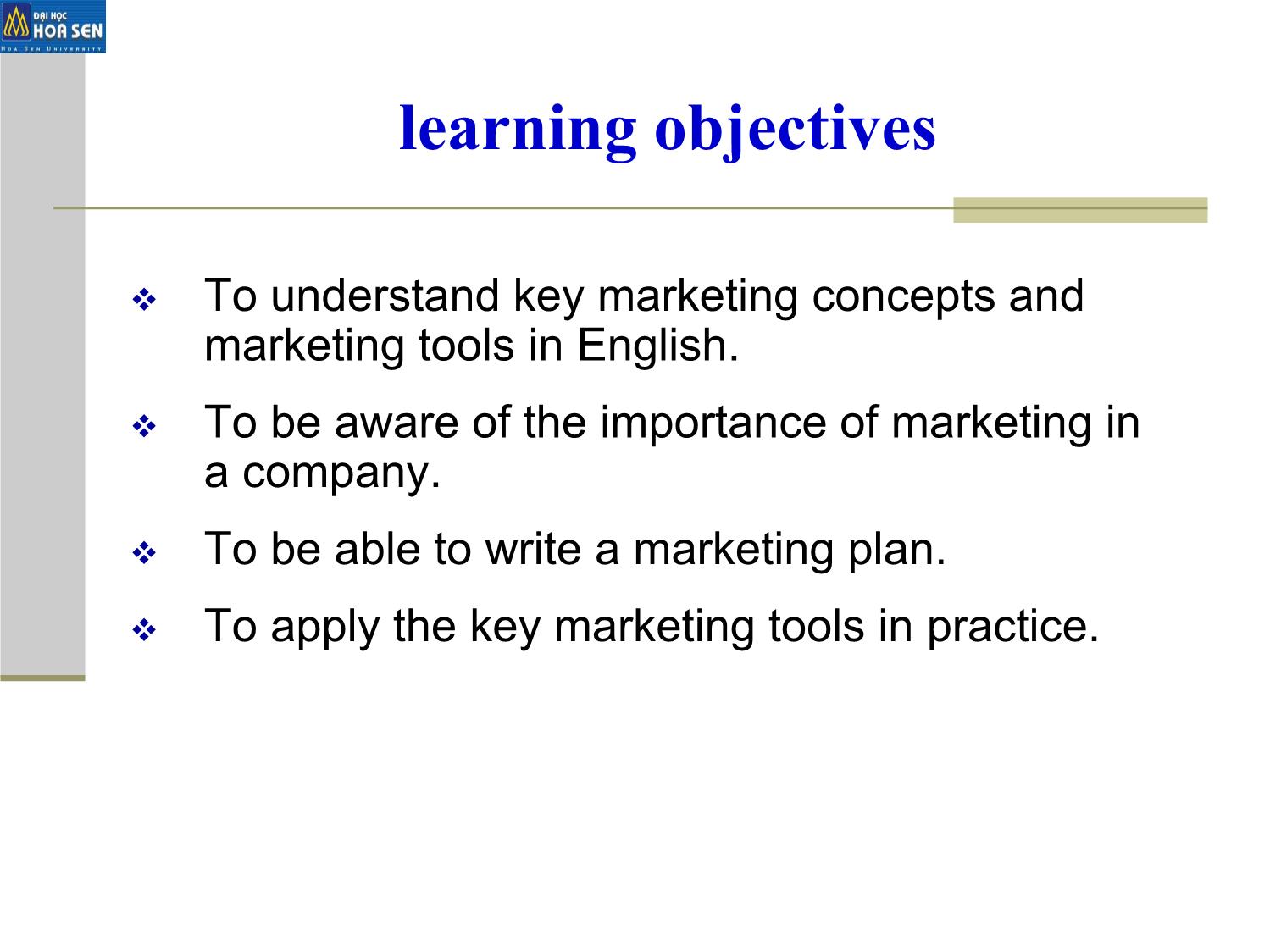
Trang 3
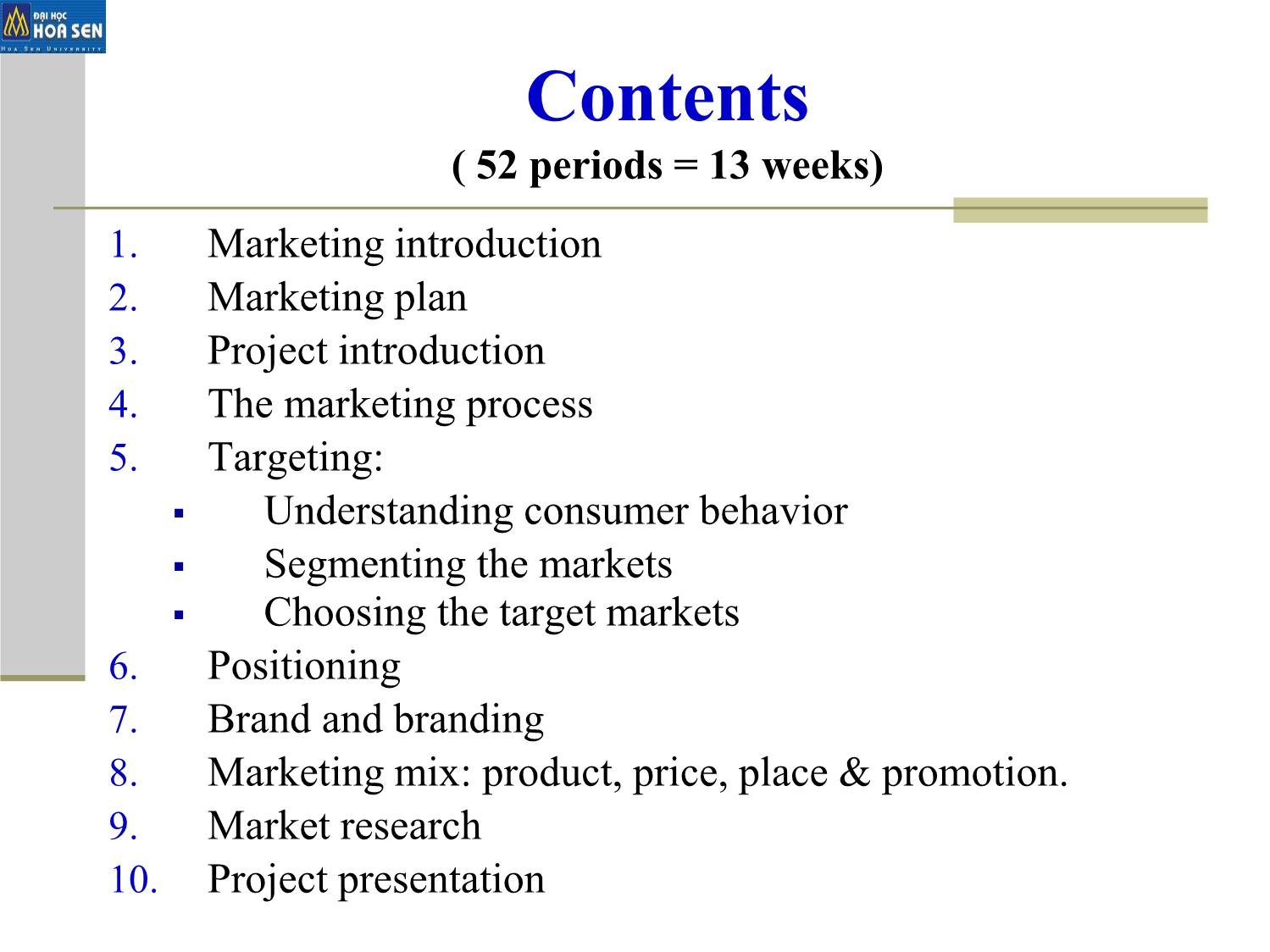
Trang 4
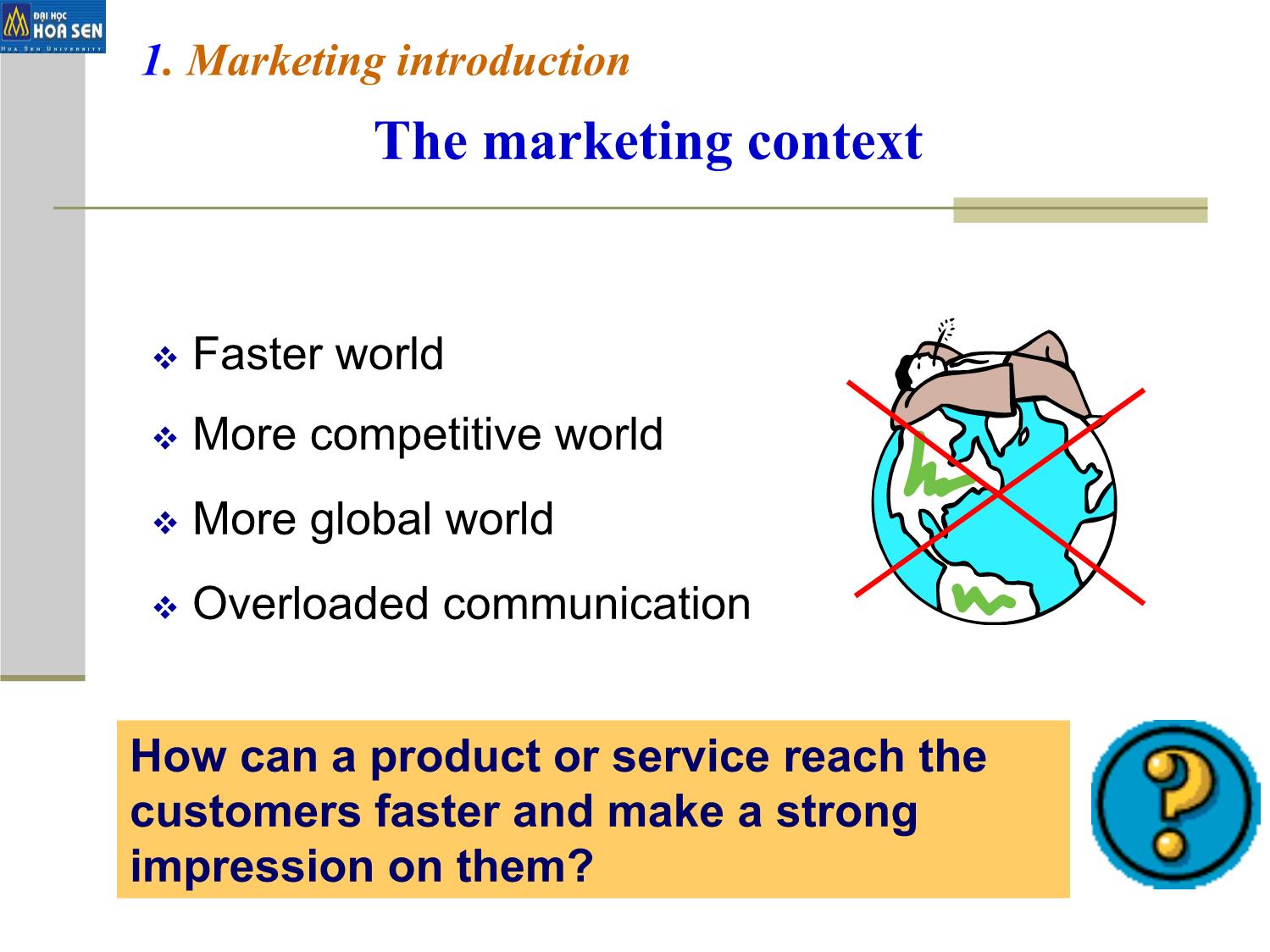
Trang 5
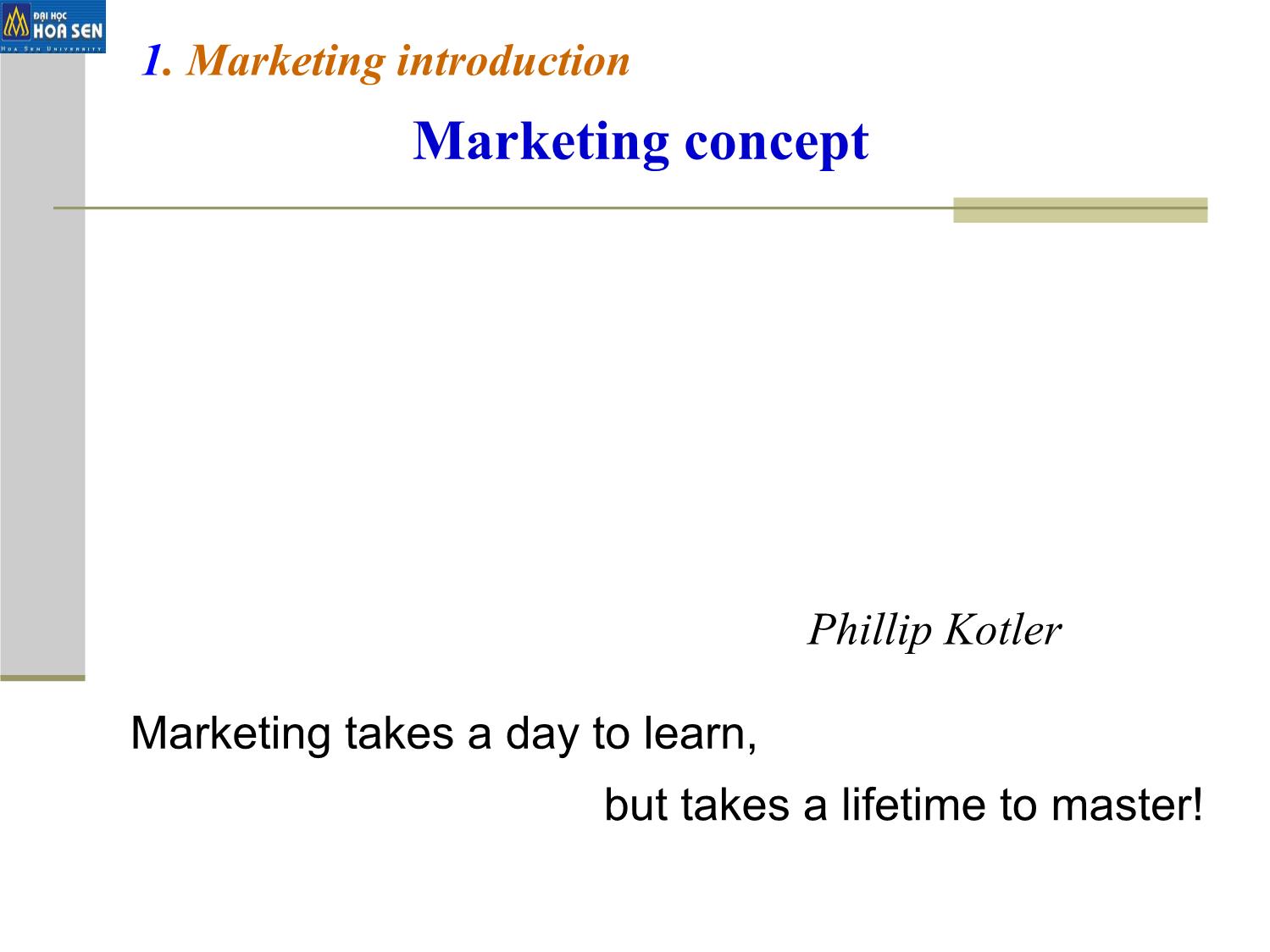
Trang 6
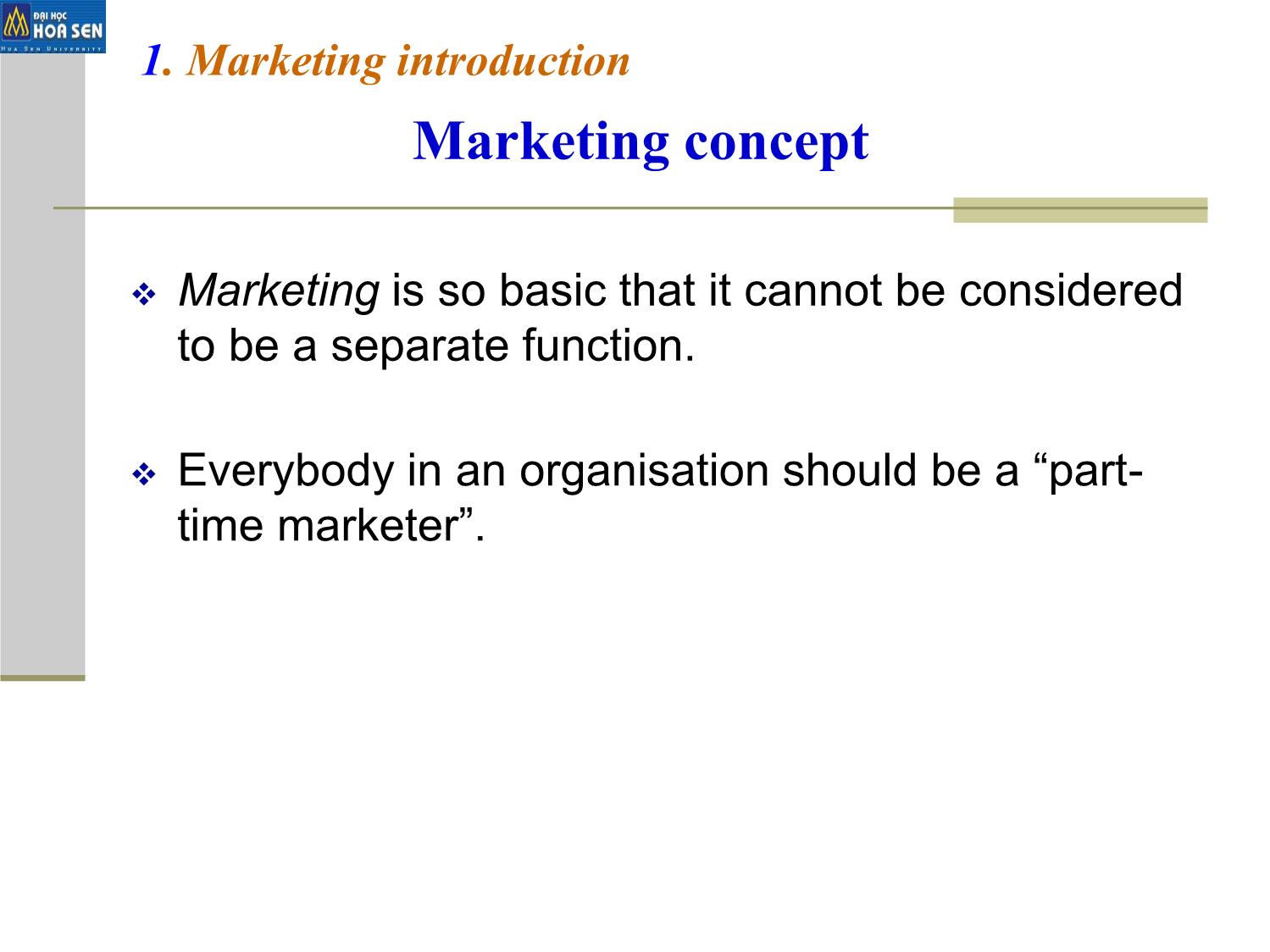
Trang 7
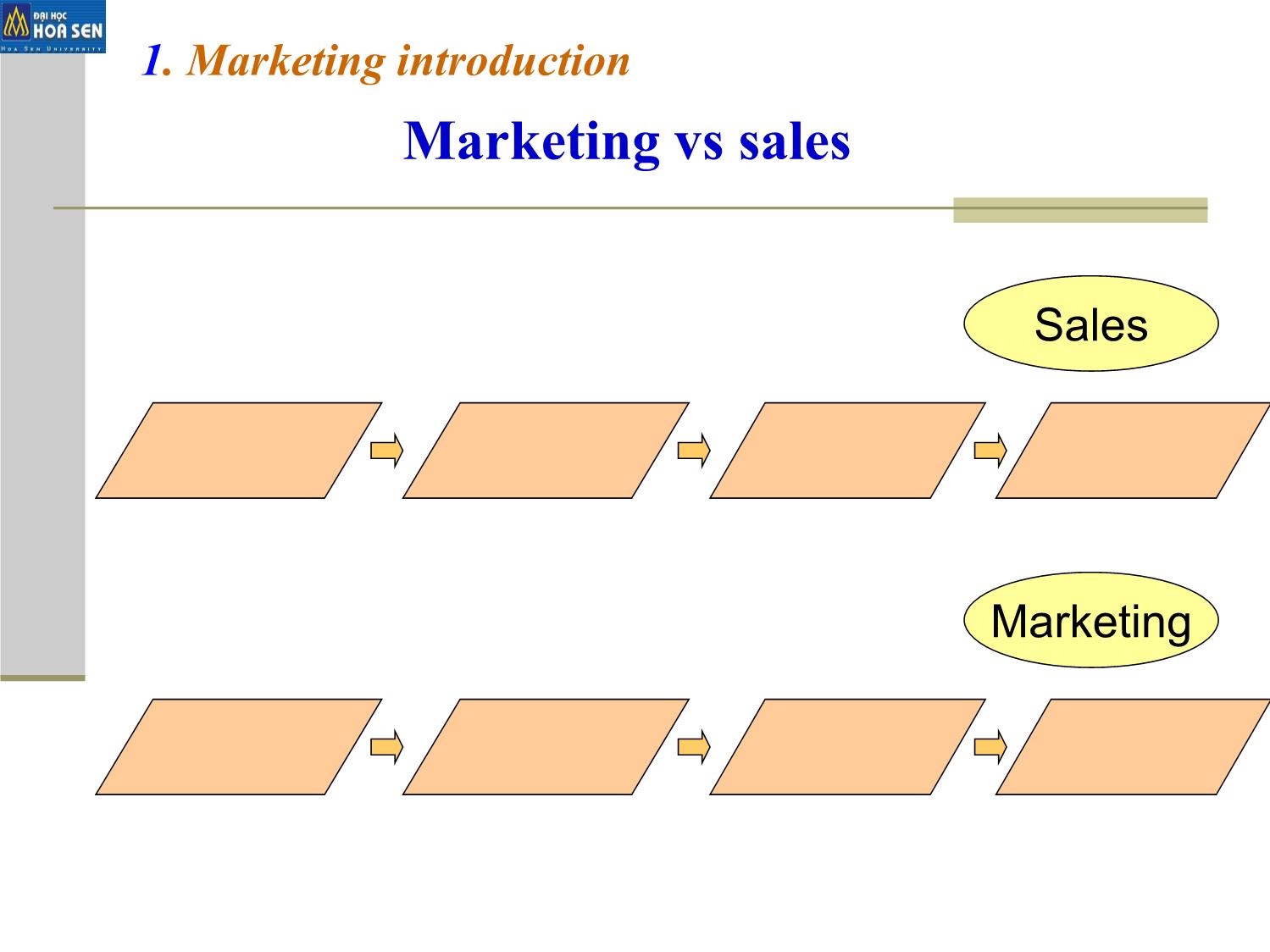
Trang 8
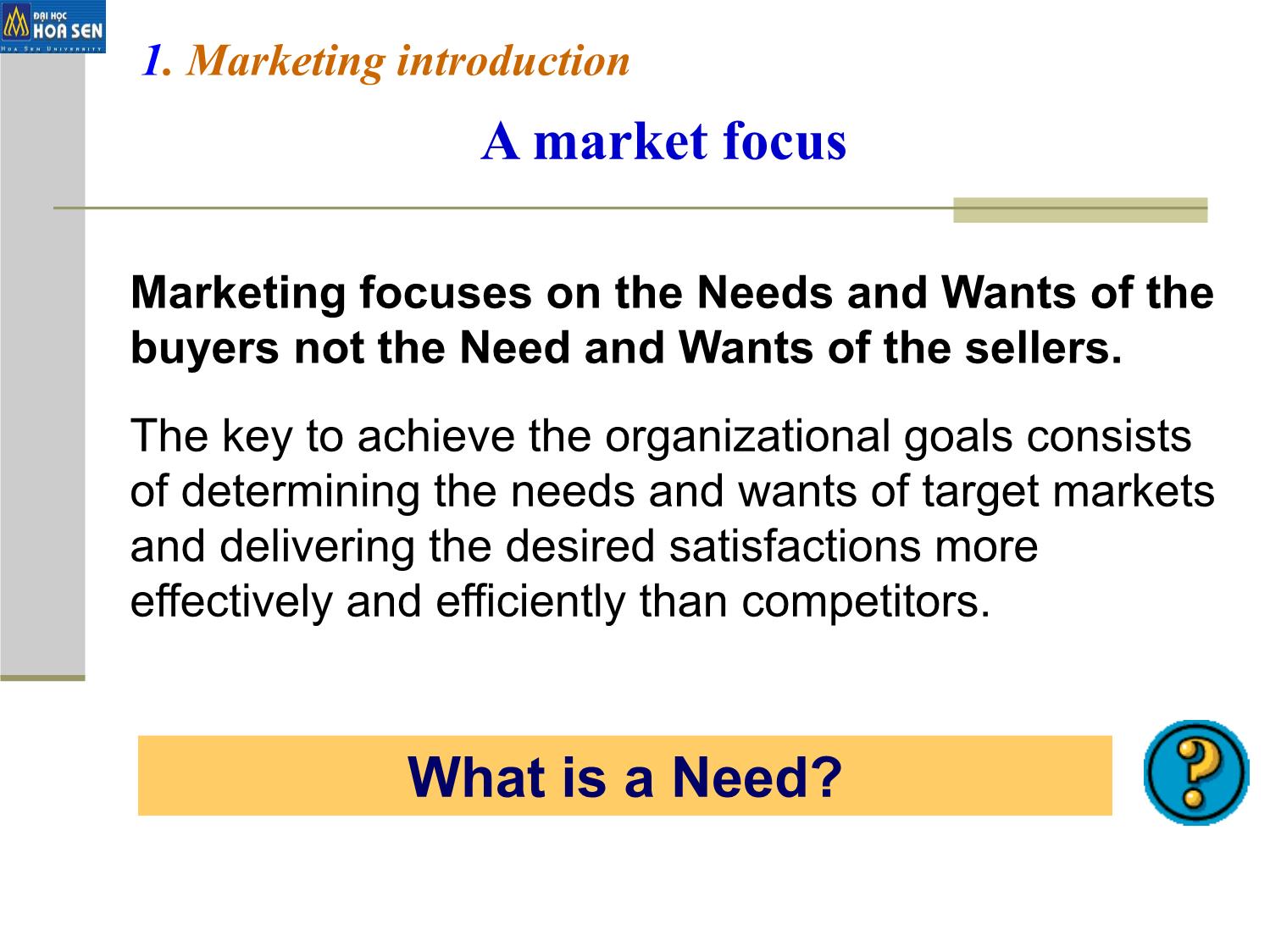
Trang 9
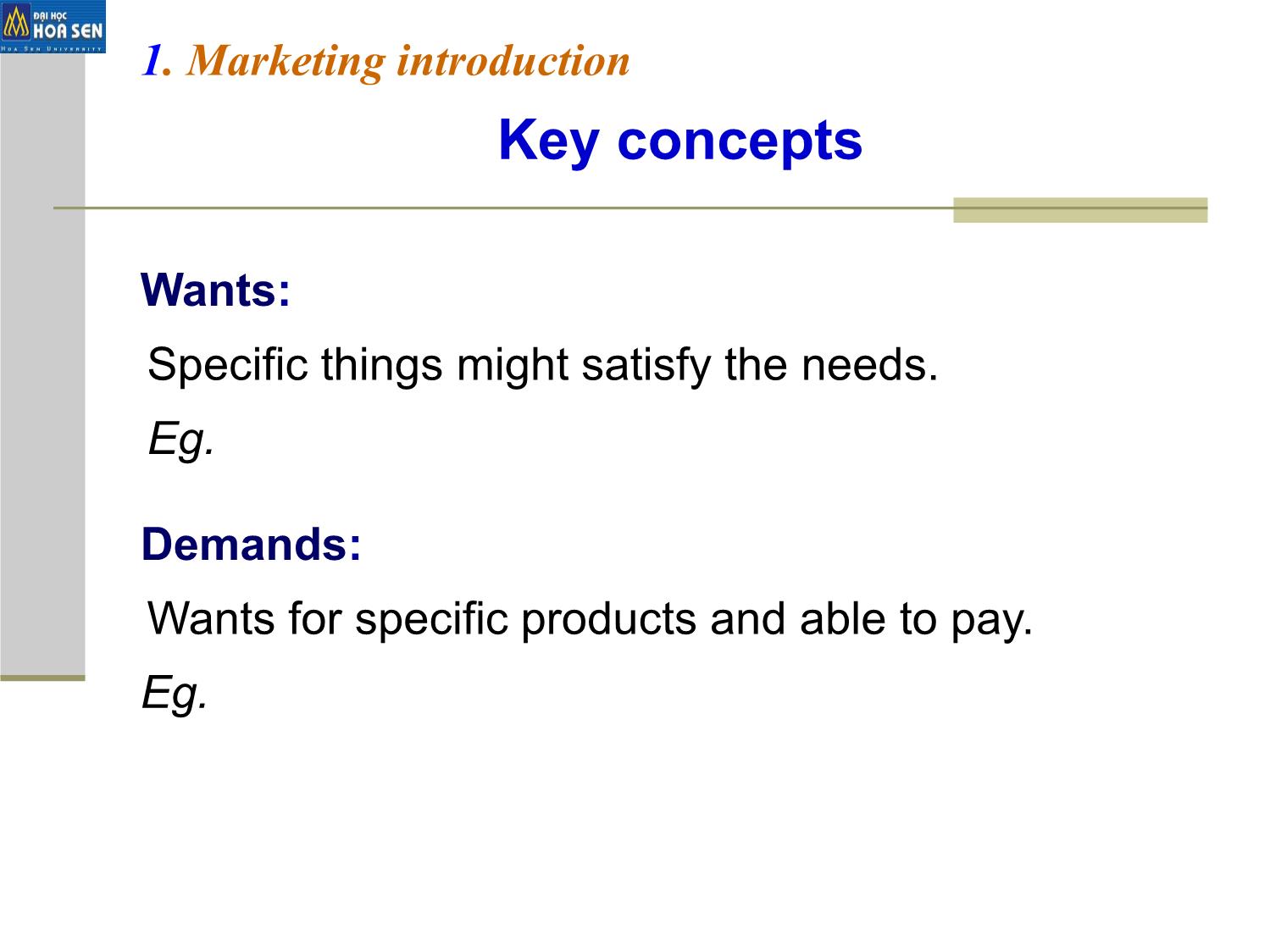
Trang 10
Tải về để xem bản đầy đủ
Bạn đang xem 10 trang mẫu của tài liệu "Bài giảng Marketing", để tải tài liệu gốc về máy hãy click vào nút Download ở trên
Tóm tắt nội dung tài liệu: Bài giảng Marketing
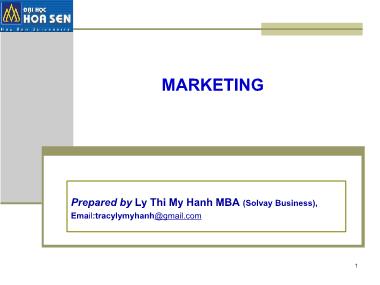
1 Prepared by Ly Thi My Hanh MBA (Solvay Business), Email:tracylymyhanh@gmail.com MARKETING Why studies Marketing? To be vital to business survival, profits & growth Offer you good career opportunities Affect your existing job and life everyday Half of every dollar spent by consumers pays for marketing costs learning objectives To understand key marketing concepts and marketing tools in English. To be aware of the importance of marketing in a company. To be able to write a marketing plan. To apply the key marketing tools in practice. Contents ( 52 periods = 13 weeks) 1. Marketing introduction 2. Marketing plan 3. Project introduction 4. The marketing process 5. Targeting: Understanding consumer behavior Segmenting the markets Choosing the target markets 6. Positioning 7. Brand and branding 8. Marketing mix: product, price, place & promotion. 9. Market research 10. Project presentation 1. Marketing introduction The marketing context More competitive world More global world Faster world Overloaded communication How can a product or service reach the customers faster and make a strong impression on them? 1. Marketing introduction Marketing concept Phillip Kotler Marketing takes a day to learn, but takes a lifetime to master! Marketing is so basic that it cannot be considered to be a separate function. Everybody in an organisation should be a “part- time marketer”. 1. Marketing introduction Marketing concept 1. Marketing introduction Marketing vs sales Sales Marketing 1. Marketing introduction A market focus Marketing focuses on the Needs and Wants of the buyers not the Need and Wants of the sellers. The key to achieve the organizational goals consists of determining the needs and wants of target markets and delivering the desired satisfactions more effectively and efficiently than competitors. What is a Need? Wants: Specific things might satisfy the needs. Wants for specific products and able to pay. Demands: Eg. Eg. 1. Marketing introduction Key concepts Needs: 1. Marketing introduction Key concepts Exchange: obtaining a desired product from someone by offering something in return. Goods or services Money, cash Sellers Customers 1. Marketing introduction Key concepts B2B (business to business) B2C (business to consumer) C2C (consumer to consumer) 1. Marketing introduction Business model 1. Marketing introduction Marketing Evolution EXTERNAL VISION INTERNAL VISION ORIENTATION ORIENTATION ORIENTATION ORIENTATION ORIENT TIME ORIENTATION 1. Marketing introduction Marketing Managment Analysis, planning, implementation, and control of marketing programs to create exchanges with target markets to achieve company goals. However, it can not do this task alone. The success will depend on other actors in the firm. Who are other actors? 1. Marketing introduction Functional structure Place of marketing in the organization Marketing HRM Finance Sales Production Now Production HRM Finance Sales Marketing Before Managing Director Finance Manager Purchasing Manager Production Manager HRM Manager Sales Manager Marketing Manager 1. Marketing introduction Functional structure 2. Marketing plan How do you organize and implement the marketing activities? A marketing plan consists of a detailed marketing program to achieve the marketing objectives and it focuses on a product or service. A plan is a roadmap to your destination. A marketing plan is a roadmap to business success. 2. Marketing plan What? What we can do without a plan? 2. Marketing plan What? Product: Brand name: Company: Start date: Submitting date: Time of period for the plan: Person submitting the plan: Person being submitted the plan: 2. Marketing plan Title page 1. Executive summary: a quick summary/ introduction of the marketing plan for quick management skimming. TABLE OF CONTENTS 3. Situation analysis: present relevant background information including the markets, macro environment, customers, competition and company 2. Purpose: brief explanation for why this plan was produced. e.g. introduce new product or enter new markets, further develop the existing product... 2. Marketing plan Content 3.1. Market overview: market of the product said 3.1.1. Geographic, demographic and psychographic 3.1.2. Market needs: 3.1.4. Market growth: 3.1.3. Market trends: 2. Marketing plan Content what the firm provides to meet the market needs consuming changes in 5 or 10 years consuming volume growth (past – present – future) Social Technological Economical Political 3.2. Macro environment (PEST analysis) 3.3. Customer behavior analysis (in general – whole markets) 2. Marketing plan Content 3.4. Competition analysis List out potential competitors including below details: Products, brand names, distribution channels Strengths Weaknesses Market share Promotion Strategy Why customers choose their products/services 2. Marketing plan Content 3.5.1. Strengths 3.5.2. Weaknesses 3.5.3. Opportunities 3.5.4. Threats 3.5. Company analysis (SWOT) 3.6. Keys to success 2. Marketing plan Content 4. Marketing strategy 4.3. Marketing objectives: it can be market share (%) or/and financials (sales volume and profit). It should be in accordance with the company’s strategy, objectives and status. It also should be SMART = Specific, Measurable, Achievable, Relevant, Timely. 4.2. Mission: identifies a stable long-run vision of a firm (what key benefits we can offer our customers) 4.4. Segmenting the markets: list how many segmen ... ials 5.1. Sales forecast: expected sales volumes or its growth percentage rate. 2. Marketing plan Content 5.2. Expense forecast: break down all expected costs, including fixed and variable cost. 2. Marketing plan Content 6. Budget required: spending requirements necessary to carry out this marketing plan. 7. Controls: Indicates how the plan will be monitored 7.1. Marketing organization: members of the project with the detailed responsibilities description. 7.2. Implementation: a detailed action plan with time, date and deadline. 7.3. Evaluation and feedback. 2. Marketing plan Content The class will be divided into groups, each one should have a group leader, responsible for assigning each member the tasks and following up. Each group will prepare a marketing plan (word), including Cover page, Title page, Table of content and Content. It will be finally submitted in the 12th week and will present (powerPoint) in the final week. 3. Project Introduction The project result will replace the mid-term exam. The topic should be defined and proceeded from now on which will discuss during the course. The group leader has to take notes all discussion in the class. 3. Project Introduction Project: submitting (Word) and presentation (PowerPoint) 40% Classroom activities and presentations 10% 4. The marketing process Consumer behaviors: personal behaviors and external incentives. Segmentation: procedure, criteria and conditions. Choosing the targets: evaluating factors and segmenting types. Marketing plan – action plan Research process & research brief Positioning statement: core benefits, differentiation & message Product Price Place Promotion Feedback, valuation, adjustment Define the background/problem and research objectives Step 1 Develop the research plan Step 2 Analyze the information Step 3 Present the findings Step 4 Market research process (4 steps) Background: What are their research objectives? Research Objectives : Define the background & research objectives Most researches are often carried out by agencies (research companies) such as ACNielsen / Taylor Nelson Sofres / Gfk / NFO / Customer Insights / Etc. To work efficiently with the agencies, firstly we have to prepare a research brief. What is a research brief? How to work with research company 4. Research methods Qualitative To explore consumer behavior (motivation, tendency, knowledge) To test concept, brand. Quantitative To measure (brand value, satisfaction, advertising efficiency) To understand habits, behavior, usage rate. Develop the research plan What they think about our product and the competitors ones. How they use the products. What motivations and attitudes they have about the products and advertising. What they feel about their “roles” in the family and society. What benefits they get from our product and the competitors do not have. 5. Targeting What we need to know about consumers The difference between the benefits (features, quality, service and image) of the product the customer gets and the money & time they spend to get the product. Providing more customer value than competitors 5. Targeting Customer value What do we do to increase the customer value? Needs and Wants Go on Personal Black box External incentives 5. Targeting How would a customer choose a product? Personal Black box Factors influence customers’ needs and wants Customer’s sensitivity in decision making process 5. Targeting How would a customer choose a product? Geographic - Region - City size - Density: urban or rural? - Climate ... Demographic - Age - Gender - Income - Education - Social class Psychographic - Personality: ambitius, strong, likeable - Lifes-tyle: short or long hair 5. Targeting Factors influence customers’ needs & wants Important or risky decision (financial & emotional issue) Daily decision or no risk for less & average income people. LEARN FEEL DO Daily decision or no risk for high income people. LEARN DO FEEL DO LEARN FEEL 5. Targeting Customer’s sensitivity in decision making process External incentives Media What is incentive? 5. Targeting How would a customer choose a product? Incentive, a benefit offered to encourage people to act in certain ways. Eg. Selling cars. 5. Targeting External incentives Motivation Possible incentive Traveling Safety Personal Advertising: Promotion: PR Direct marketing: Personal selling: 5. Targeting Media Key Family Decision Roles User Initiator Buyer Decider Influencer Eg. KFC 5. Targeting Consumer buying roles Need Recognition Information Search Evaluation of Alternatives Purchase Decision Post-purchase Behaviour Eg. Headache cure 5. Targeting The buyer decision process Markets are not identical To realize and choose the target consumers in order to be able to apply more specific marketing proposals with efficient communication. Without segmentation, we have to spread our promotional efforts very wide with much waste on people who are not interested. 5. Targeting Market segmentation: why? Segmentation: the process of splitting customers within a market into different groups, or segments who same or similar needs satisfied by a distinct marketing mix. 5. Targeting Segmentation: what? Characteristics of potential consumers 5. Targeting Segmentation criteria The markets can be segmented according to: Behaviors of potential consumers or/and GEOGRAPHIC SEGMENTATION DEMOGRAPHIC SEGMENTATION PSYCHOGRAPHIC SEGMENTATION 5. Targeting Characteristics of consumers REASONS BENEFITS 5. Targeting Behavior of consumer PRICE ATTITUDE TO PRODUCT Toothpaste market Consumers look for Consumers try to Consumers look for the Consumers concern with 5. Targeting Example: benefit segments-behavior Market segments must be Identifiable: descriptive criteria. Measurable: possible to measure the size, purchasing power and characteristic of the segment Substantial: a segment must be large and profitable enough to serve, and the largest possible identical group worth executing a marketing program. 5. Targeting Segmentation: 6 conditions Accessible: possible to effectively reach and serve the segment with promotion and product offer. Differentiable: segments are conceptually distinguishable. Actionable: possible to carry out effectively marketing programs to attract and serve the segments. 5. Targeting Segmentation: 6 conditions More efficient use of resources Potential target(s) specialization Competitive advantages can be implemented with a maximum of efficiency 5. Targeting Choosing the target(s): why? When the company has identified its market segment opportunities, it has to evaluate different segments and decide one or more segments to enter. How are the segments evaluated ? 5. Targeting Choosing the target(s) Attractiveness of the segment Objectives, strategy & resources of the company Competitive factors FACTORS 5. Targeting Factors to evaluate the segments 1. Single segment concentration M1 M2 M3 P1 P2 P3 P = Product M = Market Achieve a stronger market share More risky when the taste is changed 5. Targeting Choosing the market strategy Be higher position in the target. The sales cost is lower 2. Selective specialization M1 M2 M3 P1 P2 P3 P = Product M = Market Selective products for selective segments. Each promises to be a moneymaker. It costs much for marketing programs Diversify the firm’s risks if one segment is less profitable. 5. Targeting Choosing the market segments 3. Product specialization M1 M2 M3 P1 P2 P3 P = Product M = Market One product for some segments. Build a stronger reputation The risk occurs when the product is substituted 5. Targeting Choosing the market segments 4. Market specialization M1 M2 M3 P1 P2 P3 P = Product M = Market One segment with some products. Build a stronger reputation in the target. The risk occurs when the customer group have its purchasing budget cut. 5. Targeting Choosing the market segments 5. Full market coverage M1 M2 M3 P1 P2 P3 P = Product M = Market Serve all customer groups with all the products they might need. Only large firm can undertake this strategy. 5. Targeting Choosing the market segments 6. Positioning POSITIONING Getting into the mind of the consumers How do consumers buy the products in an over-communication when they have no concept of it. What do you look back on when mentioning below brands? 6. Positioning Positioning: starting Positioning is what the company wants their consumsers to look back and think when seeing their product or its brand. Positioning creates a specific position (compared to the competitors) of a product and its brand in the target consumers’ mind. 6. Positioning Positioning: what? Positioning starts from a product, but it is not what we do to a product, what we do to the mind of the target consumers. 6. Positioning Positioning: what? Step 1 Defining the target customers Step 2 Defining core benefits of the product Step 3 Positioning messages Step 5 Implementation 6. Positioning Positioning procedure Step 4 Positioning statement 2. Defining core benefits: Functional: Emotional: 1. Defining the target markets 6. Positioning Positioning procedure How to create core benefits: Choose them as core benefits List some outstanding needs and wants of the targets which are relevant to the products or services. Evaluate and decide the one or two that firm can do the best. 6. Positioning Positioning procedure Core benefits should be: differentiated from competitors. that target customers are willing to pay for this. that firm can carry out and make profits. 6. Positioning Positioning procedure Please define core benefits of Mem Mai Co: Mem Mai Company produces tissue. Their targets are the girl students from 15 to 23 years old, living in the outskirts. 6. Positioning Positioning procedure Impressive Short and easy to remember Meaning Look back on the benefits Consistent 6. Positioning Positioning: what? 3. Positioning messages Slogan is used as a key message to the targets. 4. Positioning statement A good positioning statement will define the direction of the brand development of the company. This statement should answer below questions? 6. Positioning Positioning procedure For the girl students from 15 to 23 years old, living in the outskirts. Who are interested in the physical benefits of the product and very sensitive to the price. Brand Soft Tissue, the best meet the demand of personal hygiene care. This brand is much better than others due to the very competitive price and acceptable quality (Dat Viet Golden Star awarded). 6. Positioning Positioning statement: e.g Big tissue – small money All media and marketing activities are based on the the positioning statement so we can send a consistent message to the targets. 6. Positioning Positioning procedure 6. Brand and branding Brand and branding 1. Brand vs trademark 2. Branding concepts 3. The importance of brand to the customers 4. Branding procedure 5. Intellectual Property Protection 7. Brand and branding Brand,. 7. Brand and branding Brand and trademark concepts Trademark. 7. Brand and branding Brand vs Trademark Brand Trademark Branding, the process of creating a unique, positive and recognizable identity for a product or service. 7. Brand and branding Branding 1. Risk avoidance 7. Brand and branding The importance of brand to the customers Physical: spend a lot of money and get unexpected quality so the famous brands are often the best choice. Time: the risk happens when it is too late. Eg see doctor. Personal security: health (hygiene, nutrition) 2. Self-image projection: externally show off. I want the people to think of who I am or how stylish I am. 7. Brand and branding The importance of brand to the customers 3. Self-assertion process: internally affirm myself with my own personality. Brand makes customers: • Faster buying decision • Safe and trusted feeling. 7. Brand and branding Branding procedure 1. Brand vision 3. Brand positioning 2. Brand strategy 5. Media campaign 6. Brand evalution & adjustment 4. Brand identity system 2. Brand strategy Strategy, tactics of a firm to compete with the competitors based on the competitive advantages to reach the objectives. 7. Brand and branding Branding procedure 1. Brand vision 7. Brand and branding Branding procedure 4. Brand identity system, a set of association which the firm wants to keep in the mind of the customers via their product, name, logo, slogan... 7. Brand and branding Branding procedure 3. Brand positioning 5. Media campaign Budget for promotion Media plan: choose suitable advertising, PR 7. Brand and branding Branding procedure 6. Brand evaluation and adjustment Evaluated via awareness levels and clear association in the mind of the targets by a survey 1. Industrial property 7. Brand and branding Intellectual Property Protection 2. Copyright:
File đính kèm:
 bai_giang_marketing.pdf
bai_giang_marketing.pdf

